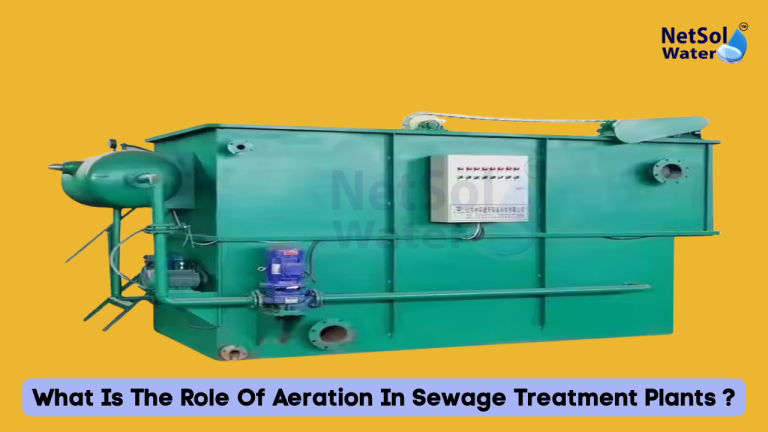
Sewage treatment is a fundamental procedure to clean wastewater before disposal to nature. Of numerous procedures included, aeration is a fundamental procedure. Without adequate aeration of sewage, biochemical processes to break down polluting chemicals in sewage would neither be effective nor feasible. This blog will be talking about the what is the role of aeration in sewage treatment plants, why it matters, how it works, and the various techniques employed to aerate sewage.
Learning about the Role of Aeration in Sewage Treatment
Aeration is done by blowing air (or even oxygen) into the wastewater or sewer. The oxygen stimulates the growth and activity of beneficial microorganisms that can destroy toxic chemicals and organic material in the water.
The role of aeration in sewage treatment is simple in that it provides aerobic environments. These environments promote the life and function of microorganisms to carry out biological treatment in the most ideal way.
Why Is Aeration Necessary?
1) Enables Microbial Action: The microorganisms used for sewage treatment plant require oxygen to break up the organic waste into simpler and less toxic substances. Aeration offers this oxygen.
2) Avoids Odor: In the absence of oxygen under anaerobic conditions, sewage can produce malodorous carrier gases such as hydrogen sulfide. Aeration avoids this odor through causing aerobic action.
3) Increases Treatment Efficiency: Aeration under suitable conditions speeds up decomposition of the pollutants, and therefore, treatment is enhanced and quicker.
4) Avoids Sludge: Organic solids are broken down by aerobic bacteria, thereby reducing sludge to be treated.
How Aeration Impacts Sewage Treatment
Air is supplied to the sewage through mechanical or diffused systems in aeration. The air oxygen dissolves in water and is used up by bacteria. Bacteria use the oxygen to oxidize the toxic organic matter to carbon dioxide, water, and new bacterial cells.
It is through this biological oxidation that contaminants in the sewage are decomposed.
Types of Aeration Systems
There are a number of ways in which aeration can be supplied to sewage treatment, some of them being:
1) Mechanical Aeration
This involves the utilization of equipment such as surface aerators or rotors for aeration of the water through the injection of air into the sewage. Mechanical aeration occurs in activated sludge processes and adds oxygen transfer and mixing.
2) Diffused Aeration
Diffused aeration uses diffusers or porous pipes at the bottom of tanks. Pressurized air is pushed through the diffusers, which create small bubbles that float up to the surface and deliver oxygen into water in an extremely efficient way. It saves energy and is applied extensively in new STPs.
3) Combination Systems
There are organisms that use a combination of diffused and mechanical aeration in an effort to maximize oxygen supply and mixing based on the treatment stage.
Influence Factors on Aeration Efficiency in Sewage Treatment
Efficiency of aeration sewage treatment is characterized by the following:
1) Oxygen Transfer Efficiency: This is relative to bubble size and diffuser size; smaller bubbles mean higher oxygen transfer.
2) Mixing: Proper mixing should be ensured so that oxygen permeates all parts of the tank and does not create dead space.
3) Temperature: More warm water, less oxygen, and thus aeration has to be controlled proportionately.
4) Characteristics of Sewage: More organic load requires more oxygen to treat the same.
Advantages of Aeration in Sewage Treatment
- Improved water quality with lesser amounts of impurities.
- Reduced sludge handling and dumping cost.
- Removal of odor from the treatment plant.
- Improved survival and activity of useful microbes.
- Compliance with environmental discharge standards.
Conclusion
The role of aeration in sewage treatment is the essence of biological wastewater degradation. By supplying required oxygen, aeration makes it possible for those microorganisms that effectively treat the sewage, odor-free it, and optimize the treatment efficiency as a whole.
Its proper installation and its maintenance guarantee efficient functioning of sewage treatment plants and ensures high-quality treated water. Whether it is mechanical or diffused aeration, proper oxygen supply is foremost for efficient sewage treatment.
Do you need an advice or assistance on selecting the best water and waste water treatment unit? We have solutions for all your problems!
Let us know your problem, our experts will make sure that it goes away.
For an assistance or related query,
Call on +91-9650608473
Or write us at enquiry@netsolwater.com
